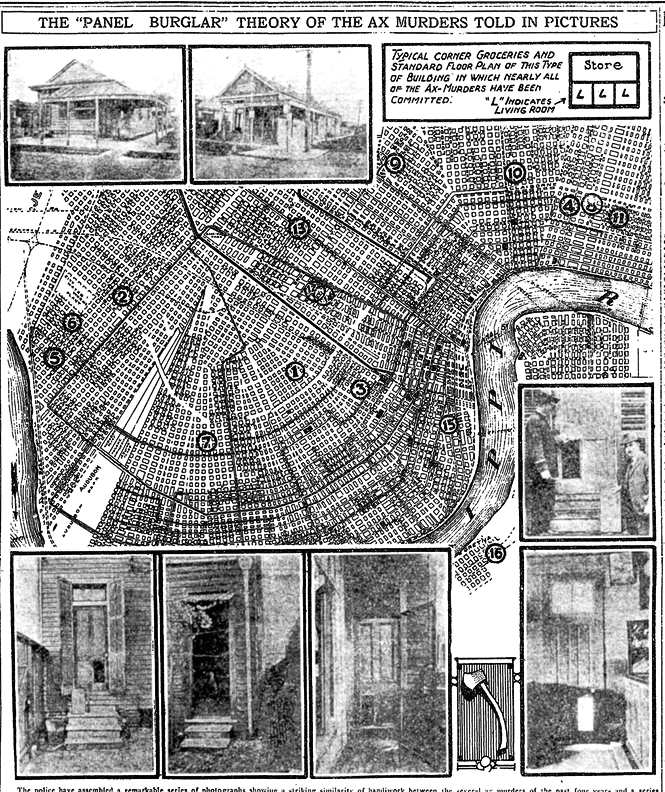
Rosa Freeman Keller
1911 - 1998
The New Orleans Recreation Department Keller Center at
1814 Magnolia Street was dedicated on
November 22, 1971.
It was named in honor of Rosa Freeman Keller who had dedicated decades of her life in New Orleans to racial and gender equality.
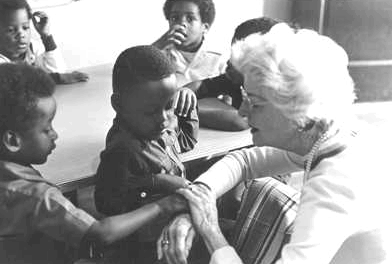 Story by Shannon Frystak
Story by Shannon Frystak
Born into enormous wealth in New Orleans in 1911, Rosa Freeman Keller used her
position to fight social injustices on many fronts. Keller championed the causes of the Civil Rights Movement, often at great
personal and financial risk. Among her many substantial contributions to the community, Keller led the effort which resulted
in the desegregation of the New Orleans public libraries.
Coca Cola heiress and
racial pioneer Rosa Freeman Keller worked tirelessly throughout her long life for those less fortunate than herself, particularly
New Orleans’s African American residents. Though her elite social background made her perhaps an unlikely social activist,
Keller helped lead the fight for the integration of public schools and transportation facilities in New Orleans. She never
hesitated to use her position in powerful organizations, such as the Independent Women’s Organization, the National
Urban League, or the Young Women’s Christian Association, to advocate for racial equality. Further, Keller encouraged
women to play an active role in the political process. The Keller Family Foundation currently continues her legacy.
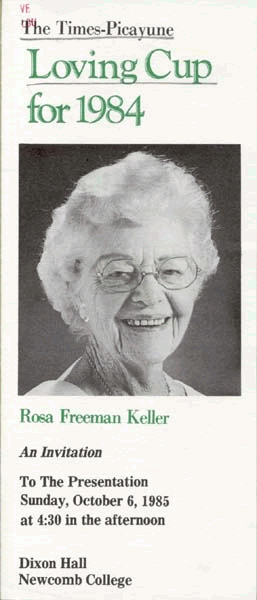 Rosa Freeman was born March 31, 1911, to Alfred Bird “A.B.” Freeman and Ella West. While her
mother descended from a family of southern aristocrats, Rosa’s father was a salesman—a “nobody from nowhere”—until
he made a fortune with his fledgling Coca Cola business. With his success, the family gained entrance into the world of the
New Orleans elite. After high school, Rosa Freeman attended Sophie Newcomb College for a year and then, anxious
to establish her independence, transferred to Hollins College in Virginia, only to drop out a year later. At her social debut
in New Orleans, Rosa Freeman met Charles Keller II, whom she married in 1932. After a few itinerant years because of Charles’s
work in the armed services, the Keller family settled in New Orleans in 1944.
Rosa Freeman was born March 31, 1911, to Alfred Bird “A.B.” Freeman and Ella West. While her
mother descended from a family of southern aristocrats, Rosa’s father was a salesman—a “nobody from nowhere”—until
he made a fortune with his fledgling Coca Cola business. With his success, the family gained entrance into the world of the
New Orleans elite. After high school, Rosa Freeman attended Sophie Newcomb College for a year and then, anxious
to establish her independence, transferred to Hollins College in Virginia, only to drop out a year later. At her social debut
in New Orleans, Rosa Freeman met Charles Keller II, whom she married in 1932. After a few itinerant years because of Charles’s
work in the armed services, the Keller family settled in New Orleans in 1944.
Already a member of the New Orleans
chapter of the League of Women Voters, Keller began her foray into the world of politics working on voter registration. When
her mother died in 1945, Keller was asked to serve on the local YWCA board, an integrated organization that deeply impacted
her views on race relations. In 1947, seeking to alleviate the housing shortage for New Orleans’s black families, Rosa
and Charles Keller, along with friends and philanthropists Edith and Edgar Stern, financed the construction of Pontchartrain
Park, one of the first middle-class black communities in the country.
Keller expanded her political involvement in the early 1950s when she helped organize the Independent Women’s
Organization, created to support the election of moderate mayoral candidate deLesseps Morrison. When Morrison asked Keller
to serve on the board of the public library system, she readily accepted, becoming the first woman to serve on a citywide
board. Almost immediately Keller brought controversy to her position when she set out to integrate the New Orleans public
library system—a goal she eventually achieved.
Keller continued to serve the New Orleans black community in a
variety of ways. She chaired the board of Flint-Goodridge Hospital, a facility that catered to the black community. In this
capacity, she fought for and won access to Blue Cross coverage for the New Orleans black community, and insisted that African
American medical students have access to New Orleans’s medical libraries. Keller also served as president of the New
Orleans Urban League, and on the boards of numerous citywide interracial organizations.
In 1953, Keller decided that
it was time the League of Women Voters, an organization she loved, begin the process of admitting black members. With the
help of her progressive peers, she succeeded in integrating the organization in 1955. State laws passed in the wake of the
U.S. Supreme Court’s decision in Brown v. Board of Education, however, forced to the league to resegregate a year later.
Through Keller’s persistence, the league permanently achieved integrated status in 1963.
In 1958 Keller led
the fight to desegregate the New Orleans public transportation system, but she considered her efforts to integrate the city’s
public schools as “her war.” Toward this end, Keller helped create Save Our Schools (SOS), an organization dominated
by elite white women in the New Orleans community. During the 1960 New Orleans School Crisis, when the first
black children attended formerly all-white schools, SOS ferried children to and from the integrated schools. They also raised
monies for the black and white families who kept their children in the schools and lobbied the state legislature on behalf
of integrated schools. Much to the chagrin of some family members, Keller also personally financed the legal fight to desegregate
Tulane University in 1963. Through the years, Rosa Keller had no qualms about holding interracial gatherings in her Uptown
home, though it was considered a serious breach of racial etiquette at the time.
Keller received numerous honors for
her work on racial issues in New Orleans, including the Times-Picayune Loving Cup Award, which honors New Orleans residents
who have worked unselfishly for the community without expectation of public acclaim or material reward. She also received
an honorary alumnus degree from Newcomb College and an honorary doctorate from Dillard University.
She died in April 15, 1998, in New Orleans. The Keller Family Foundation, established in 1949, continues
to provide monies to sustain and improve the New Orleans community. The Rosa F. Keller Library
& Community Center at 4300 S. Broad was named for her on October 6, 1999
Frystak,
Shannon. "Rosa Keller." KnowLA Encyclopedia of Louisiana. Ed. David Johnson. Louisiana Endowment for the
Humanities, 31 Jan. 2011. Web. 20 Nov. 2013.
Photos from the New Orleans Public Library.
One of Rosa Keller's first important actions as a member of the Library Board, and surely her most famous, was her ultimately
successful campaign to desegregate the city's library facilities. These pages from the minutes of the March 10, 1954 Board meeting record Mrs. Keller's lonely position as
the sole promoter of integration. Within a matter of months, however, her goal was realized and the Library administration decided that it would not enforce
any continued attempt to maintain separation of the races in NOPL facilities. [New Orleans Public Library Records]
You Can Support this Site by Clicking on & Shopping from this Amazon Link -- and it
won't cost you a penny more:


American minstrel music composer and performer Luke Schoolcraft was born in New Orleas on November 13,
1847. He appeared in numerous minstrel shows throughout the North after the American Civil War. He died on -
March 10, 1893.
Natchez II was the first built for Captain Thomas P. Leathers, at Crayfish
Bayou, and ran from 1845 to 1848. It was a fast two-boiler boat, 175 feet long, with red smokestacks,
that sailed between New Orleans and Vicksburg, Mississippi. It was built in Cincinnati, Ohio,
Leathers sold it in 1848. It was abandoned in 1852. Natchez III was funded by the sale of the second. It was
191 feet long. Leathers operated it from 1848 to 1853. On March 10, 1866, it sank at Mobile,
Alabama due to rotting.
The New Orleans Lyceum and Library Society had its origins in the 1844 ordinance passed by the Second
Municipality Council, "Providing for the establishment of a Lyceum and Library by the Scholars of the Public Schools
of Municipality No. Two." That law created a "Lyceum and Library" whose cost was to be defrayed by voluntary
contributions of the students (not to exceed twenty-five cents per month or $3.00 annually). Upon making a total contribution
of $9.00 the student became a life member of the Society. Other individuals could become subscribers to the library at terms
set by the board of directors, which was identical to the directors of the public schools in the municipality. Certain public
officials were ex-officio members and public school teachers were honorary members. Once $5,000 was collected and paid
into the Treasury the Municipality would provide rooms for the library, and when $15,000 had been paid in, a lot and building
would be make available to the institution. In addition to payments by the students, donations were also accepted from interested
individuals. The library opened on March 10, 1846 with 3,400 books in its collection; by 1858 it held
over 10,000 volumes. Originally located in temporary quarters, the Lyceum Library moved into the new municipality hall (now
Gallier Hall) when its rooms in that building were ready for occupancy.(NOPL)
With the creation of the system of parish government in Louisiana in 1807 the "administrative functions
were vested in a body comprised of the parish judge, the justices of the peace, and a jury of twelve inhabitants appointed
by [the judge]." Following statehood the Legislature, by act of March 25, 1813, provided that each parish be divided
into wards, with each ward to elect a representative to serve a two-year term on the Police Jury. The juries were to meet
in July of each year at the parish seat, with the parish judge as president and the justices of the peace as his associates.
Police Juries were empowered to regulate a wide range of activities, from police of the slaves to the building of roads and
bridges and the levy of taxes in support of such public works. The 1813 act specified that the Orleans Parish jury would have
no jurisdiction within the city of New Orleans. This meant that it was to function only in the unincorporated portions of
the parish. There existed continuous debate as to just what was part of the city and what was unincorporated, although the
latter area was generally recognized to include the Lakefront area, Gentilly, eastern New Orleans, the right bank of the river,
and all of the land that became Jefferson Parish by legislative act in 1825. An act of March 10, 1834 attempted
to clarify some of the confusion as to the authority of the Orleans Parish Police Jury. (NOPL)
On Saturday, April 30, 1803, the Louisiana Purchase Treaty was signed by Robert Livingston, James
Monroe, and Barbé Marbois in Paris. Jefferson announced the treaty to the American people on July 4. After the signing
of the Louisiana Purchase agreement in 1803, Livingston made this famous statement, "We have lived long, but this is
the noblest work of our whole lives...From this day the United States take their place among the powers of the first rank."
The United States Senate ratified the treaty with a vote of twenty-four to seven on October 20. The Senators who voted against
the treaty were: Simeon Olcott and William Plumer of New Hampshire, William Wells and Samuel White of Delaware, James Hillhouse
and Uriah Tracy of Connecticut, and Timothy Pickering of Massachusetts. On the following day, the Senate authorized President
Jefferson to take possession of the territory and establish a temporary military government. In legislation enacted on October
31, Congress made temporary provisions for local civil government to continue as it had under French and Spanish rule and
authorized the President to use military forces to maintain order. Plans were also set forth for several missions to explore
and chart the territory, the most famous being the Lewis and Clark Expedition. France turned New Orleans over on December
20, 1803 at The Cabildo. On March 10, 1804, a formal ceremony was conducted in St. Louis to transfer ownership
of the territory from France to the United States. Effective on October 1, 1804, the purchased territory was organized into
the Territory of Orleans (most of which became the state of Louisiana) and the District of Louisiana, which was temporarily
under the control of the governor and judges of the Indiana Territory.
Pat O'Brien's Sue Wheeler/
Sara Belle Wheeler Passes Away
March 10, 1956
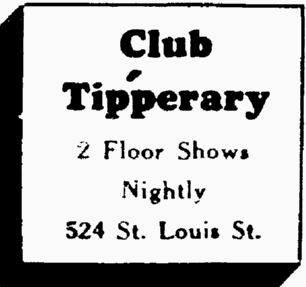
During prohibition, North Carolina native Charlie Cantrell was running rum in Plaquemine. He was also a master of the
"Shake Up" which involved mixing grain alcohol with flavorings to create concoctions tasting like gin, whiskey,
rum, and other liquors. "Sometimes it wasn't too good, but it could get you drunk", said Cantrell. Benson
Harrison "Pat" O'Brien was a customer who bootlegged liquor back home to Birmingham. They became friends.
O'Brien, after several business endeavors, moved to New Orleans and ran a
speakeasy. After prohibition, on December 3, 1933 he opened a package liquor store at Royal and St.
Peter Street. In 1934 he opened Club Tipperary at 524 St. Louis. (The advertisement at the right ran in the Times-Picayune
on March 18, 1934.) Cantrell financed it. Then, as equal partners, they moved to another location in the 600 block of St.
Peter Street across from the original store. Cantrell later bought 10% of O'Brien's share, making him the controlling
partner. In December, 1942 they moved to the current location of the world famous Pat O'Brien's bar at 718 St. Peter
and called it Pat O'Brien's.
The building was historic long before
Cantrell and O'Brien made it famous. Built in 1791, it housed the first Spanish theater in the United States.
The famous Hurricane cocktail was first mixed there 146 years later. In 1937 a liquor salesman was hawking 60 bottles
of rum at a bargain basement price and would even throw in 15 dozen glasses shaped like the globes of oil fueled hurricane
lamps. The rum wasn't selling as Cantrell had hoped, so he decided to experiment. He mixed 4 ounces of it with red fruit
juice and sugar, and instructed his waiters to tout these drinks. Customers loved them and their glasses. Cantrell,
a savvy businessman began selling both.
That same year (1937),
Mercedes Paulson and Sue Wheeler first performed together at the dueling pianos (thought to be the first in the country).
"Sue" was actually Sara Belle Wheeler, a native of Vicksburg who had been educated in New Orleans. She passed
away on Saturday, March 10, 1956 at the age of 38 after having played at Pat O's for 19 years. Mercedes
LeCorgne Paulson, a native New Orleanian, died on Thursday, April 10, 1980 at the age of 74. Her booming
baritone, which graced main bar for 32 years, is still remembered by many. She retired from Pat O'Brien's in 1968.
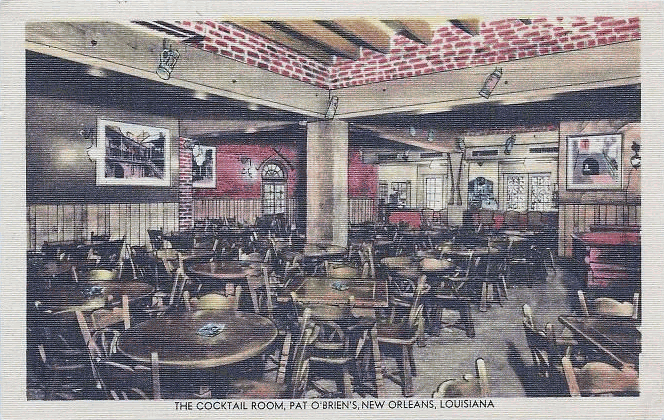
Charlie ran the business. Pat handled the customers. They were perfect partners for the business. During World War II,
Cantrell worked in a defense shipyard where he met George Oechsner, who would become the bars General Manager, taking Cantrell's
place and becoming part owner in 1947. In 1979 Oechsner's son George "Sonny" Jr. took over the role. It was
Sonny's idea to begin franchising and Pat O'Brien's bars sprouted up in
Orlando, San Antonio, Memphis,
Cancun, and Destin. Sonny also added a restaurant upstairs, purchased
a building on Bourbon Street for expansion, opened a location at the Jaz Brewery, introduced an online catalog for selling
branded items, and acquired a bottling plant.
The guys who ran
the place for so many years are all gone now. Pat O'Brien died on November 10, 1983. Geroge D.
Oechsner Jr. followed on December 11, 1990. Charlie Cantrell passed away on March 23, 1993.
Sonny died on March 12, 2012. But the business the two bootleggers started and the local men continued
remains, now an iconic New Orleans bar known around the world.
Upon
Sonny's death, his daughter Shelly Oechsner Waguespack became Pat O'Brien's president and sole owner.
1947 postcard
Two
Year-old Mary Cortimiglia is Killed While Sleeping in Her Mother's Arms
The Ax Man a Suspect
March 10, 1919.
A Wave of Terror
Michael Pepitone/Pipitone was attacked on the night of October
27, 1919. His wife was awakened by a noise and arrived at the door of his bedroom just as a large, axe-wielding
man was fleeing the scene. Mike Pepitone had been struck in the head, and was covered in his own blood. Blood splatter covered
the majority of the room, including a painting of the Virgin Mary. Mrs. Pepitone, the mother of six children, was unable
to describe any characteristics of the killer. The Pepitone murder was the last of the alleged axman attacks.
The Axman was an alleged
serial killer active in and surrounding communities, including Gretna, from May 1918 to October 1919. Press reports during
the height of public panic about the killings mentioned similar murders as early as 1911, but recent researchers have called
these reports into question.
In each of the murders one or more of the residents was killed with either an axe (which often belonged to the victims)
or a straight razor and the murderer never removed items from the victims' homes. In most cases, the back door of a
home was smashed or the door panels were removed to allow entrance into the homes. The majority of the victims were
Italian-Americans.
The
first victims were Joseph and Catherine Maggio. Joseph Maggio. He was an Italian grocer who
was attacked on May 22, 1918 while sleeping alongside his wife, Catherine, at their home on the corner of
Upperline and Magnolia Streets, where they conducted a barroom and grocery. The killer broke into the home, and then proceeded
to cut the couple's throats with a straight razor. Upon leaving he bashed their heads with an axe, perhaps in order to conceal
the real cause of death. Joseph survived the attack, but died minutes after being discovered by his brothers Jake and Andrew
Maggio. Catherine died prior to the brothers' arrival, her throat having been cut so deep that her head was nearly severed
from her shoulders. In the apartment, law enforcement agents found the bloody clothes of the murderer, as he had obviously
changed into a clean set of clothes before fleeing the scene. A complete search of the premises was not completed by police
after the bodies were removed, yet later the bloody razor, which had been used to conduct the murders, was found in the lawn
of a neighboring property. Police ruled out robbery as motivation for the attacks, as money and valuables left in plain sight were not stolen
by the intruder. The razor used to kill the couple was found to belong to Andrew Maggio, the brother of the deceased who conducted
a barber shop on camp street. His employee, Estaben Torres, told police that Maggio had removed the razor from his shop
two days prior to the murder, explaining that he had wanted to have a nick honed from the blade.Maggio, who lived in the
adjoining apartment to his brother's residence, discovered his slain brother and sister-in-law roughly two hours after the
gruesome attacks had occurred, upon hearing strange groaning noises through the wall. Maggio blamed his lack of notice to
the attacks that had occurred in the early morning hours to his intoxicated state, after a night of celebration prior to
his departure to join the navy, yet police were nonetheless surprised that he failed to hear the intruder as he made a forced
entry into the home.Andrew Maggio became the police chief's prime suspect in the crime, yet was released after investigators
were unable to break down his statement, as well as his account of an unknown man who was supposedly seen lurking near the
residence prior to the murders.
Louis
Besumer and his mistress Harriet Lowe, were attacked in the early morning hours of June
27, 1918, in the quarters at the back of his grocery which was located at the corner of Dorgenois and Laharpe Streets.
Besumer was struck with a hatchet above his right temple, which resulted in a possible skull fracture. Lowe was hacked over
the left ear, and found unconscious when police arrived at the scene. The couple was discovered shortly after 7 AM on the
morning of the attack by John Zanca, driver of a bakery wagon who had come to the grocery in order to make a routine delivery.
Zanca found both Besumer and Lowe in a puddle of their own blood, both bleeding from their heads. The axe, which had belonged to Besumer, was found in the bathroom of the apartment. Besumer later stated to police
that he had been sleeping when he was bashed with the hatchet.Almost immediately, police arrested potential suspect Lewis
Oubicon, a then 41 year old African American man who had been employed in Besumer's store just a week before the attacks.
No evidence existed which could have proved the man guilty, yet police arrested him nonetheless, stating that Oubicon had
offered conflicting accounts of his whereabouts on the morning of the attack. Shortly after the attempted murder Lowe stated
that she remembered having been attacked by a mulatto man, yet her statement was discounted by police due to her disillusioned
state. Robbery was said to be the only possible explanation for the attacks, yet no money or valuables were removed from
the couple's home.Oubicon was later released as police were unable to gather sufficient evidence to hold him accountable
for the crimes. Media attention soon turned to Besumer himself, as a series of letters written in German, Russian, and Yiddish
were discovered in a trunk at the man's home. Police suspected that Besumer was a German spy, and government officials began
a full investigation of his potential espionage. Weeks later, after going in and out of consciousness, Harriet Lowe told
police that she thought Besumer was in fact a German spy, which led to his immediate arrest. Two days later Besumer was
released, and two lead investigators of the case were demoted due to unacceptable police work. Besumer was once again arrested
in August 1918, after Harriet Lowe, who lay dying in Charity Hospital after a failed surgery, stated that it was he who had
attacked her more than a month previously with his hatchet. He was charged with murder, and served nine months in prison
before being acquitted on May 1, 1919 after a ten minute jury deliberation.
Harriet Lowe was attacked while in bed with Louis Besumer. As is mentioned
previously, Lowe was hacked above her left ear and found unconscious at the scene of the crime before she was rushed to Charity
Hospital. Lowe became the center of a media circus, as she continually made scandalous and often false statements relating
to both the attacks and the character of Louis Besumer, some of which are described in the preceding description. The Times-Picayune
sensationalized Lowe and her outspoken nature upon discovering that she was not the wife of Besumer, but his mistress. A
Charity Hospital source discovered the scandal, when Besumer asked to be directed to the room of "Mrs. Harriet Lowe,"
and was inevitably denied access as no woman by that name was a patient. Besumer's legal wife arrived from Cincinnati in
the days immediately following the discovery, which further inflamed the ongoing drama. Lowe further gained media attention
as she repeatedly made statements which voiced her dislike of the New Orleans chief of police, as well as her reluctance
to comply with police questioning. After the truth of her marital status was revealed publicly, Lowe told reporters from
the Times-Picayune that she would no longer aid the police in their investigation, as she suspected that it had been Chief
Mooney who first informed the press of the scandal. Despite the scandal, and her delirious statements which suggested that Besumer was a German spy, Lowe returned to
the home she shared with Besumer weeks after the attack. One side of her face was partially paralyzed due to the severity
of the attack. Lowe died August 5, 1918, just two days after doctors performed surgery in an effort to repair her partially paralyzed
face. Just prior to her death, Lowe told authorities that she suspected it was Louis Besumer who had attacked her.
Mrs.
Schneider was attacked in the early evening hours of August 5, 1918. The 8 months pregnant, 28
year old of Elmira Street, awoke to find a dark figure standing over her, and was bashed in the face repeatedly. Her scalp
had been cut open, and her face was completely covered in blood. Mrs. Schneider was discovered after midnight by her husband,
Ed Schneider, who was returning late from work. Schneider claimed that she remembered nothing of the attack, and gave birth
to a healthy baby girl two days after the incident. Her husband told police that nothing was stolen from the home, besides
six or seven dollars that had been in his wallet. The windows and doors of the apartment appear to have not been forced
open, and authorities came to the conclusion that the woman was most likely attacked with a lamp that had been on a nearby
table. James Gleason, who police said was an ex-convict, was arrested shortly after Schneider was found. Gleason was later
released due to a complete lack of evidence, and stated that he originally ran from authorities because he had so often been
arrested. Lead investigators began to publicly speculate that the attack was related to the previous incidents involving
Besumer and Maggio.
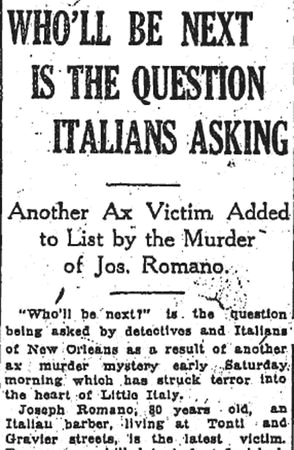
Joseph
Romano was an elderly man living with his two nieces, Pauline and Mary Bruno. On August 10, 1918,
Pauline and Mary awoke to the sound of a commotion in the adjoining room where their uncle resided. Upon entering the room,
the sisters discovered that their uncle had taken a serious blow to his head, which resulted in two open cuts. The assailant
was fleeing the scene as they arrived, yet the girls were able to distinguish that he was a dark-skinned, heavy-set man,
who wore a dark suit and slouched hat. Romano, although seriously injured, was able to walk to the ambulance once it arrived,
yet died two days later due to severe head trauma. The home had been ransacked, yet no items were stolen from Romano. Authorities
found a bloody axe in the back yard, and discovered that a panel on the back door had been chiseled away. The Romano murder
created a state of extreme chaos in the city, with residents living in constant fear of an axman attack. Police received
a slew of reports, in which citizens claimed to have seen an axman lurking in New Orleans neighborhoods. A few men even called
to report that they had found axes in their back yards. John Dantonio, a then retired Italian detective, made
public statements in which he hypothesized that the man who had committed the axman murders was the same who had killed
several individuals in 1911. The retired detective cited similarities in the manner by which the two sets of homicides had
been committed, as reason to assume that they had been conducted by the same individual. Dantonio described the potential
killer as an individual of dual personalities, who killed without motive. This type of individual, Dantonio stated, could
very likely have been a normal, law abiding citizen, who was often overcome by an overwhelming desire to kill. He later
went on to describe the killer as a real-life "Dr. Jekyl and Mr. Hyde".
Charles
Cortimiglia was an immigrant who lived with his wife and baby on the corner of Jefferson Avenue and Second Street
in Gretna. On the night of March 10, 1919, screams were heard coming from the Cortimiglia Residence. Grocer
Iorlando Jordano rushed across the street to investigate when he heard screams from the Cortimiglia residence.Upon his arrival,
Jordano noticed that Charles Cortimiglia, his wife Rosie, and their infant daughter, Mary, had all been attacked by the unknown
intruder. Rosie stood in the doorway with a serious head wound, clutching her deceased daughter. Charles lay on the floor,
bleeding profusely. The couple was rushed to Charity Hospital, were it was discovered that both had suffered skull fractures.
Nothing was stolen from the house, but a panel on the back door had been chiseled away. A bloody axe was found on the back
porch of the home. Charles was released two days later, while his wife remained in the care of doctors. Upon gaining full
consciousness, Rosie made claims that Iorlando Jordano and his 18 year old son, Frank, were responsible for the attacks.
Iorlando, a 69 year old man, was in too poor of health to have committed the crimes. Frank Jordano, more than six feet tall
and weighing over 200 pounds, would have been too large to have fit through the panel on the back door. Charles Cortimiglia
vehemently denied his wife's claims, yet police nonetheless arrested the two, and charged them with the murder. The men
would later be found guilty. Frank was sentenced to hang, and his father to life in prison. Charles Cortimiglia divorced
his wife after the trial. Almost a year later, Rosie announced that she had falsely accused the two out of jealousy and
spite. Her statement was the only evidence against the Jordanos, and they were released from jail shortly thereafter.
Rosie
Cortimiglia was the wife of immigrant laborer Charles Cortimiglia. She was attacked alongside her husband on March
10, 1919 while sleeping with her baby in her arms. She was badly wounded by the axman, but survived the incident.Mary
Cortimiglia was the two-year-old daughter of Charles and Rosie Cortimiglia. She was killed while sleeping in her
mother's arms with a single blow to the back of the neck when she and her parents were attacked on March 10, 1919.
On March 13, 1919, a letter purporting
to be from the Axman was published in the newspapers saying that he would kill again at 15 minutes past midnight on the
night of March 19, but would spare the occupants of any place where a jazz band was playing. That night many New Orleans's
dance halls were filled, while bands played jazz. Victolas also played jazz in home living rooms. There were no murders
that night. The letter read:March 13, 1919
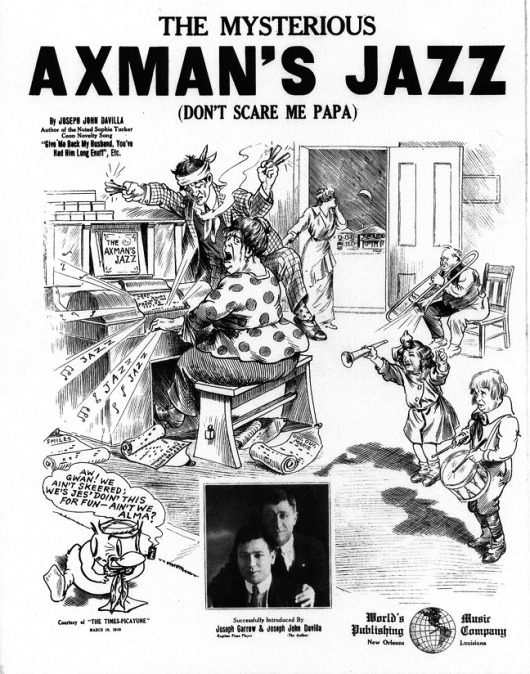
Hell, March 13, 1919
Esteemed Mortal:
They have never caught me and they never will. They have never seen me, for I am invisible, even as the ether
that surrounds your earth. I am not a human being, but a spirit and a demon from the hottest hell. I am what you Orleanians
and your foolish police call the Axman.
When I see fit, I shall come and claim other
victims. I alone know whom they shall be. I shall leave no clue except my bloody axe, besmeared with blood and brains of
he whom I have sent below to keep me company.
If you wish you may tell the police to be careful not to rile me. Of course, I am a reasonable spirit. I
take no offense at the way they have conducted their investigations in the past. In fact, they have been so utterly stupid
as to not only amuse me, but His Satanic Majesty, Francis Josef, etc. But tell them to beware. Let them not try to discover
what I am, for it were better that they were never born than to incur the wrath of the Axman. I don‘t think there
is any need of such a warning, for I feel sure the police will always dodge me, as they have in the past. They are wise
and know how to keep away from all harm.
Undoubtedly, you Orleanians think of me as a most horrible murderer, which I am, but I could be much worse
if I wanted to. If I wished, I could pay a visit to your city every night. At will I could slay thousands of your best citizens,
for I am in close relationship with the Angel of Death.
Now, to be exact, at 12:15 (earthly time) on next Tuesday night, I am going to pass over New Orleans. In
my infinite mercy, I am going to make a little proposition to you people. Here it is:
I am very fond of jazz music, and I swear by all the devils in the nether
regions that every person shall be spared in whose home a jazz band is in full swing at the time I have just mentioned. If
everyone has a jazz band going, well, then, so much the better for you people. One thing is certain and that is that some
of your people who do not jazz it on Tuesday night (if there be any) will get the axe.
Well, as I am cold and crave the warmth of my native Tartarus, and it is
about time I leave your earthly home, I will cease my discourse. Hoping that thou wilt publish this, that it may go well
with thee, I have been, am and will be the worst spirit that ever existed either in fact or realm of fancy.
The Axman
Some
citizens sent the newspapers invitations (to be published) for the Axman to visit their homes on that St. Joseph's Day evening
and see who would be killed first. One invitation promised to leave a window open for the Axman, politely asking that he
not damage the front door. A song was written (see above) by Joseph John Davilla titled "The Mysterious Axman's
Jazz (Don't Scare Me Papa) and published by the World's Music Publishing Company which maintained an office at 413 Godchaux
Building.
Steve Boca was a grocer
who was attacked in his bedroom as he slept, by an axe-wielding intruder on August 10, 1919. Boca awoke
during the night to find a dark figure looming over his bed. Upon regaining consciousness, Boca ran to the street to investigate
the intrusion, and found that his head had been cracked open. The grocer ran to the home of his neighbor, Frank Genusa,
where he lost consciousness and collapsed. Nothing had been taken from the home, yet, once again, a panel on the back door
of the home had been chiseled away. Boca recovered from his injuries, but could not remember any details of the trauma.
It should be noted that this attack took place after the emergence of the infamous axman letter.
Sarah Laumann was attacked
on the night of September 3, 1919. Neighbors came to check on the young woman, who had lived alone, and
broke into the home when Laumann did not answer. They discovered the 19 year-old lying unconscious on her bed, suffering
from a severe head injury and missing several teeth. The intruder had entered the apartment through an open window, and
attacked the woman with a blunt object. A bloody axe was discovered on the front lawn of the building. Laumann recovered
from her injuries, yet couldn't recall any details from the attack.
Police
arrested several suspects but all were cleared of charges. However, a murder in 1921 brought attention to the wife of
the last of the axman's victims when Esther Pepitone Albano shot and killed Joseph Mumfry in Los Angeles. Mumfry's criminal
record in New Orleans included a 1915 arrest for the murder of Vincent Moreci of which he was cleared. He had been convicted
for dynamiting the grocery of C. Graffignino at 241 South Claiborne and spent two years in the penitentiary before being paroled
in 1917. Soon after he was arrested for carrying a concealed weapon and sent back to prison for the parole violation.
He was realeased three months before Pepitone's murder. In 1919 he was again arrested in New Orleans -- in his pocket
was a notebook containg the the name of Angelo Albano (1100 Howard Avenue) along with aproximately 100 other names of "Italians"
living in the city as well as in Chicago, Shreveport, Baton Rouge, New York, and other cities. Police suspected that
this was his blackmail list but could find no proof.
Not long after Michael
Pepitone's muder, his widow married Anglo Albano (who was included in Mumfry's notebook). In 1917 Albano and Mumphry
were arrested together in Jefferson Parish. According to Esther Pepitone Albano, her second husband went missing on
October 27, 1921 after Mumfry repeatedly threatened death to both she and her husband unless they turned
over money to him. Mrs. Albano said that she was sure that Mumfry had killed her husband. She said that on December
5, 1921 Mumfry came to her and demanded $500 and threatened to kill her if she refused, so she shot him in self defense.
At the time of his death, Mumfy was using the alias "M. G. Leone".
From http://en.wikipedia.org/wiki/The_Axeman_of_New_Orleans and The Times-Picayune.
Related reading:







 Story by Shannon Frystak
Story by Shannon Frystak Rosa Freeman was born March 31, 1911, to Alfred Bird “A.B.” Freeman and Ella West. While her
mother descended from a family of southern aristocrats, Rosa’s father was a salesman—a “nobody from nowhere”—until
he made a fortune with his fledgling Coca Cola business. With his success, the family gained entrance into the world of the
New Orleans elite. After high school, Rosa Freeman attended
Rosa Freeman was born March 31, 1911, to Alfred Bird “A.B.” Freeman and Ella West. While her
mother descended from a family of southern aristocrats, Rosa’s father was a salesman—a “nobody from nowhere”—until
he made a fortune with his fledgling Coca Cola business. With his success, the family gained entrance into the world of the
New Orleans elite. After high school, Rosa Freeman attended  During prohibition, North Carolina native Charlie Cantrell was running rum in Plaquemine. He was also a master of the
"Shake Up" which involved mixing grain alcohol with flavorings to create concoctions tasting like gin, whiskey,
rum, and other liquors. "Sometimes it wasn't too good, but it could get you drunk", said Cantrell. Benson
Harrison "Pat" O'Brien was a customer who bootlegged liquor back home to Birmingham. They became friends.
During prohibition, North Carolina native Charlie Cantrell was running rum in Plaquemine. He was also a master of the
"Shake Up" which involved mixing grain alcohol with flavorings to create concoctions tasting like gin, whiskey,
rum, and other liquors. "Sometimes it wasn't too good, but it could get you drunk", said Cantrell. Benson
Harrison "Pat" O'Brien was a customer who bootlegged liquor back home to Birmingham. They became friends. Charlie ran the business. Pat handled the customers. They were perfect partners for the business. During World War II,
Cantrell worked in a defense shipyard where he met George Oechsner, who would become the bars General Manager, taking Cantrell's
place and becoming part owner in 1947. In 1979 Oechsner's son George "Sonny" Jr. took over the role. It was
Sonny's idea to begin franchising and Pat O'Brien's bars sprouted up in
Charlie ran the business. Pat handled the customers. They were perfect partners for the business. During World War II,
Cantrell worked in a defense shipyard where he met George Oechsner, who would become the bars General Manager, taking Cantrell's
place and becoming part owner in 1947. In 1979 Oechsner's son George "Sonny" Jr. took over the role. It was
Sonny's idea to begin franchising and Pat O'Brien's bars sprouted up in 